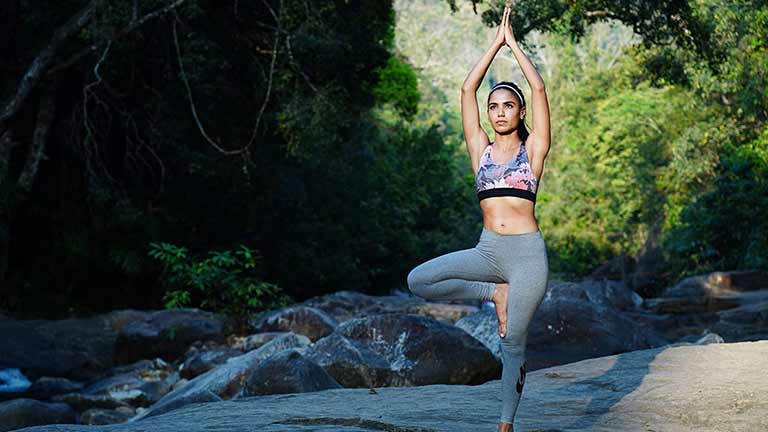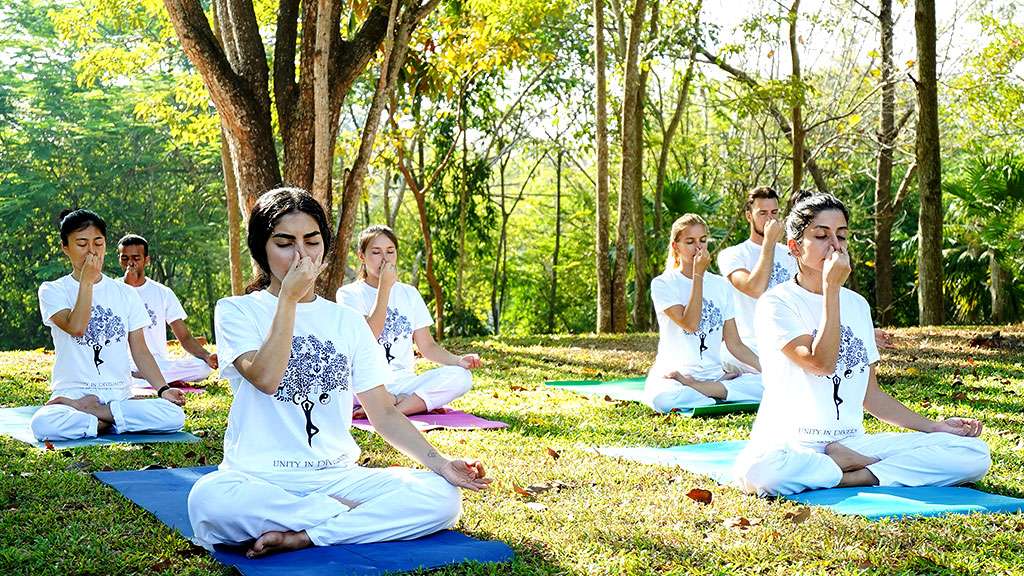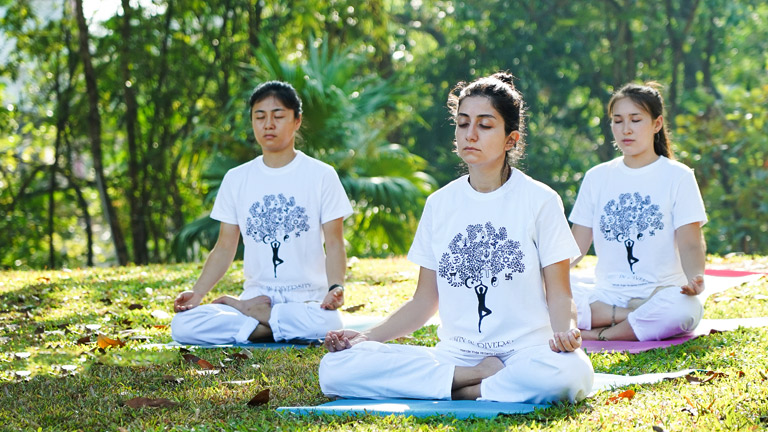


Traditionally, asanas have been described as postures that best relax the body. This quality of relaxation has made the practice accessible to large numbers of people who lead taxing lifestyles. The asanas are done in standing, sitting and reclining positions. There are more complex postures as well. Taken together, these asanas focus on instilling balance. Hatha Yoga is a branch of yoga that gives emphasis for force. Haṭha literally means "force".

The Surya Namaskar is among the primary yogic practices. It is hugely popular among yoga practitioners even today. The practice of Surya Namaskar is meant to channel the energy of the cosmos - the sun, in particular - into the body of the yogi. In line with this, Surya Namaskar is to be ideally practised in the early mornings. The Surya Namaskar comprises 12 steps - these can be identified as 10 distinct asanas. The First Position Stand erect. Face the east, so that you are facing the direction of the rising sun. Ensure that your feet are close together. Keep your knees straight. Breathe evenly. Exhale slowly. Fold your arms to bring your palms together at your chest level, as if in prayer. The Second Position Inhale slowly. Raise your arms over your head and keep them stretched. Arch backwards gradually. The Third Position Exhale slowly. Bend forward from your waist, moving your outstretched arms downwards as you do. Let both your palms touch the floor on either side of your feet. Keep your arms straight at the elbows. You must bend forward till your forehead touches your knees. The Fourth Position Inhale again. Stretch your right leg backwards till you are squatting down over your left foot. Allow your right knee to rest on the floor. Keep your chin raised. The Fifth Position Hold your breath. Let your arms bear the weight of your body and slowly stretch your left leg backwards. Now, your body must form a plank. The Sixth Position Exhale. Bend your legs so that your knees drop to the floor. Lower your chest until it touches the floor too. Ensure that your abdomen and hips are still raised. Let your forehead rest on the floor. The Seventh Position Inhale. Lift your head off the floor. Slide your body forward and upward by arching your back. You should appear like a cobra poised to strike. Allow your elbows to bend but keep your palms firmly on the floor. Your body should remain on the floor from the hips down. The Eighth Position Exhale. Raise your hips while keeping your head down, between your arms. Your torso should move backwards and upwards while your arms and feet are placed firmly on the floor. Your body is in the shape of an inverted “V” now. The Ninth Position Inhale. Bring your right leg forward so that your right foot rests between your hands. Lift your head up simultaneously. Notice that this position is similar to the fourth. The Tenth Position Exhale. Bring your left leg forward so that your left foot too rests between your hands. Simultaneously, touch your knees with your forehead. Ensure that your neck is relaxed. Notice that this posture is similar to the third position. The Eleventh Position Inhale. Straighten your body out slowly. Keep your arms outstretched so that they are over your head now with your fingers pointing upwards. Slowly bend backward in a gentle arch and let your arms bend too. Notice that this posture is similar to the second position. The Twelfth Position Exhale slowly. Straighten your torso and arms back up till you are standing erect. Lower your arms till your fingers point downwards. Allow your body to relax. Notice that you have now come back to the first position. The Surya Namaskar functions as an effective exercise as well. It combines many postures and hence renders the body flexible with practice.

Today, aspects of the yogic discipline associated with improving the body are the most popular. These aspects include “asanas”, “pranayama” and “pratyahara”. The Sanskrit word “prana” refers to respiration. The word “ayama”, also of Sanskrit origin, refers to “control”. Pranayama refers to the regulation of breathing. Pranayama allows for a sense of control over the entire body as “prana vayu” or the air one breathes pervades the entire being. Pranayama and Asana The practice of pranayama is often combined with the practice of asanas today. The calm of mind required for maintaining an asana can be achieved through pranayama. One might even notice that the instructions for practising asanas themselves integrate breath control into the discipline. Before assuming a posture or asana as well as after establishing a posture, the yogi is required to focus on regulating his or her breathing. For instance, in order to faithfully practise the Surya Namaskar, one has to regulate inhalation and exhalation when transitioning from one position to the next. The Surya Namaskar comprises 12 positions - forming 10 distinct asanas - and each position demands specific breathing patterns, switching between deep inhalation, slow exhalation and holding of the breath. Prana + Ayama = Pranayama The Word Pranayama is derived from Prana + Ayama. Prana means Life or Breath and Ayama means extending. It is believed that Pranayama can prolong your lifespan. In the practice of yoga asanas, pranayama or breath control translates into even and deep breathing. Yoga practitioners who focus on pranayama increase the span of their inhalations, exhalations and even the holding of breath. This practice comes from the belief that an individual’s lifespan is measured not in days or years but in the number of breaths he or she takes. In line with this belief, pranayama looks to increase the lifespan of the practitioner by increasing the depth but reducing the number of breaths drawn in a day. It is believed that any individual draws approximately 21,600 breaths (including inhalation and exhalation) within 24 hours. In Sanskrit, inhalation is referred to as “puraka” while exhalation is known as “rechaka”. Prolongation of breathing happens when the breath is held between inhalations and exhalations. This holding is referred to as “kumbhaka”. The primary text that details the practice of classical yoga is the Yoga Sutras by Sage Patanjali. It is from the Yoga Sutras that classical yoga draws guidance even for its better-known aspects like asanas (or body postures) and pranayama (or breathing techniques). The core principles of pranayama practised even today are gleaned from the Yoga Sutras. The popularity of pranayama as a yogic practice can be attributed to its meditative quality. While most forms of cardio exercise aim to increase heart rate and activity levels in general, yoga focuses on maintaining equilibrium. This makes pranayama increasingly relevant in a time of high-stress lifestyles. Pranayama takes on a meditative quality because it demands the focus of mind. Focusing solely on breathing patterns keeps the mind relatively still, and imparts a deep sense of relaxation. This belief is common to both classical as well as modern schools of yoga.

The discipline of yoga is a combination of asanas or bodily postures, breathing techniques, cleansing techniques and meditation. While the more traditional or classical forms of the discipline have continued to focus on the spiritual benefits of yoga, the discipline has evolved vastly. Today, aspects of the yogic discipline associated with improving the body are the most popular. These aspects include “asanas”, “pranayama” and “pratyahara”. Pratyahara refers to the process of detaching oneself from one’s sensory surroundings. This can only be achieved when the focus of the mind is taken away from the numerous stimuli perceived by the sensory organs. Instead, the attention of the mind is turned inward. This is the meditative process. While practitioners today do not lay emphasis on the classical definition of “pratyahara”, meditation is still widely practised. Meditation, as it is understood today, can be seen as a culmination of the internal aspects of yoga as they were traditionally defined. The yogic discipline sees the merging of the individual with the higher consciousness as its goal. This is impossible if the yogi is constantly distracted by bodily or sensory desires. Hence, the yogi picks an object or idea of his/ her choosing and focuses solely on it. This may even be a simple name. When an individual is able to sustain focus on the object or name chosen in the previous stage, dhyana is practised. Dhyana refers to meditation. In this stage, the yogi remains focused inward, and only on the singular object or name or idea. Traditionally, during meditative yoga, the yogi is completely detached from the material world, and focused solely on the merging of his or her consciousness with a greater spiritual power. In modern terms, meditative yoga simply means that the individual is detached from worldly concerns and focused on stilling his/ her mind.